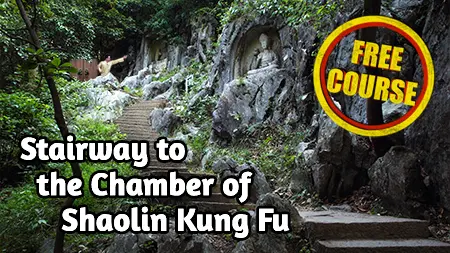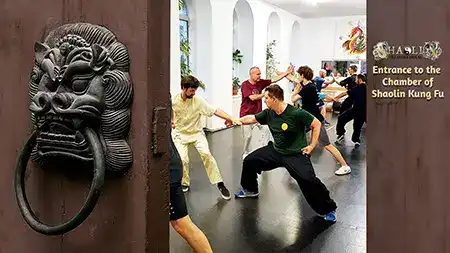Kung Fu’s "Bitter Training" and your way out of it

Clenched teeth, aching muscles, bruised knuckles, trying to withstanding the pain, hard to breath, endure, endure, just a little longer…
This common experience is summarized as “Ku Lian” or “Bitter Training” in Kung Fu circles. Reinforced by the predominant “no pain, no gain” paradigm it constitutes the standard of martial arts training today.
Heavy workouts, lifting weights, rope jumping, jogging, hitting pads, punching sandbags and getting hit and kicked at to become conditioned against pain make up the usual routine martial artists have to go through. Most people accept this is a necessary means to become stronger. Some even like it, but I assume the majority is just pushing trough.
But there’s a different way to excel in Kung Fu. One that is even enjoyable along the way.
Don’t get me wrong! Kung Fu is a demanding endeavour that requires consistency and patience.
It’s probably to most complete way to train your whole being; from head to toe, from body to mind, from combat to purifying your soul.
While overcoming the things that hold you back and constantly extending your limits can be tough at times, the training itself doesn’t need to be “bitter” if you use a smart (but rare) method.
Shaolin Kung Fu is generally regarded a hard and external martial art. The soft and internal aspects are usually revealed exclusively to advanced students only after many years of practice.
What if you could simply skip the torment of going through the long and strenuous physical conditioning phase?
If you could just access the deeper and more profound methods of high-level Kung Fu for building energy and developing combat skills that are normally reserved for inner chamber disciples?
There’s good news for you:
You don’t need to learn it “the hard way”.
Although some people translate “Kung Fu” as “hard work”, the term rather refers to a “skill acquired through consistent practice”.
While well-built men can reach fairly high combat efficiency by making use of their physical strength (and therefore often train this aspect only), you should be aware that this is not the only way to become a good fighter.
It is not without reason that Chinese generals were often slim-sized and some of the best fighters in Kung Fu history were elegant ladies.
In traditional Kung Fu, technique, “internal force” and speed are all regarded superior to physical strength (in this order of importance).
But why do so many people prefer to build a body of iron then?
Here are a few reasons:
- Most people probably never heard of the aforementioned hierarchy of skills.
- Only few are aware that there’s another way to train Kung Fu, as they’ve never been exposed to it.
- Building muscles is much easier and faster than cultivating Qi, although it is much less enjoyable.
- The methodology to train internal force is and always was rare, so in relation to fitness coaches there’s just a few people who can teach it effectively.
- The effects of hard physical training are easier to confirm. A six pack also looks good to many people. This is just a very superficial benefit but hey, we’re living in a superficial world…
Time to rethink the approach!
In traditional Chinese philosophy, building big muscles is actually detrimental to energy flow. Qi that is locked up in one’s muscles is referred to as “dead energy”, as it is not available to sustain the internal organs.
But harmonious energy flow is a prerequisite to building internal force.
From this perspective, it is actually counterproductive to toughen your body, only to learn internal training later, where relaxation is key.
It also takes time to re-program bad habits acquired through years of tensing up with every punch.
If you learn to stay relaxed and to generate an energy flow right from the start, you can jump into high-level training directly.
Making limitations obsolete
I don’t want to play down the usual approach consisting of heavy fitness workouts, punching sandbags and hardening your bones. You can become a good fighter by doing so and if you like it, keep doing it.
Just bear in mind that as you age, your physical strength will naturally decline, making even more and even harder training necessary to keep your level.
Internal training is not limited by age, size or gender and the longer you practice, the more energy you will have acquired.
So, at the point a boxer ends his career, the internal martial artist who started at the same time will enter his golden years. Who do you think will feel better emotionally? Who will have less chronic pain from sustained injuries?
Another view on training Kung Fu
My aim for this blog post is to provide you with another perspective. Just accept that there’s not only one way to become strong and combat efficient and respect other people’s opinion on that matter.
The next time you clench teeth during your training, you might think of what I wrote and reflect if it’s really worth to endure the pain, especially if you’re not a professional fighter.
But be warned! Do not just give up on physical training without substituting it with effective internal practice. You need to train force, one way or the other, to fuel your punches.
If you’re ready to let go of the usual paradigm, you may ask to learn at the Shaolin Treasure House to experience the deeper methods to cultivate your body, energy and mind passed down by the past masters.
No more waiting till the internal methods are revealed to you – only to find out that your school doesn’t have them in store anyway.
You can stop feeling exhausted after your training and instead feel fresh and alert.
I’ve gone through both approaches and you can easily tell which one I personally find superior from what I practice and teach today... not to mention which one I find more enjoyable. 😉
You'd like to know our unique Kung Fu Training?
Then grab this free Online Mini Course now!
In it you'll learn first important basics:
- 3 Kung Fu Stances
- 2 traditional Kung Fu Techniques
- 1 Exercise of Combat Application
- Traditional und modern Philosophy in Kung Fu
In my extensive 6-month program, you can also develop a solid foundation for your martial arts practice directly.
In doing so, you also lay the foundation for training internal force, or Qi, and learn how to transform your Kung Fu practice into meditation.
Related Topics:
Young Man’s Kung Fu Journey
Read the inspiring story of a typical young man's Kung Fu Journey!
⚠ WARNING! After that you'll have to decide if you'd like to change your understanding of Kung Fu forever.
January 1, 2025
[BREAKING] Interview with Shaolin Kung Fu
Shaolin Kung Fu has a great story to tell. Learn more about its family and how you can implement it to meet the challenges of modern life.
January 8, 2022
Is Shaolin Kung Fu the Ultimate Training?
he benefits of practicing Shaolin Kung Fu are so manifold that I conclude it is probably the most beneficial training you can take on. Find out more in this video.
November 25, 2021
How to learn to use your Kung Fu
Many schools miss a strategic approach to spontaneous Kung Fu application. Read about the steps you need to take from Kung Fu form to sparring and fighting using what you learned.
April 29, 2022
Can you learn Kung Fu online?
What's really important when learning Kung Fu, the depth of the teaching or the means of transmission? Read about the Pros and Cons of learning online and offline.
December 3, 2021
Traditional Shaolin Kung Fu Combat Application Combat Sequences to "Cross-Roads at 4 Gates"
Cross-Roads at 4 Gates was the fundamental set taught at the Southern Shaolin temple. This sequences show the partner form, based on real Kung Fu combat application.
September 25, 2022
Categories
Shaolin Qi Gong
Shaolin Kung Fu
Martial Arts
Benefits
Learning
Customs & Moral Code
Sneak Peak
VLOG Video
History
Follow Us
Author

Sifu Leo
Shaolin Wahnam Instructor
Hey there!
I’m Sifu Leo, Kung Fu enthusiast, father, drummer and computer geek from Austria. And, as many say, a kind and patient person and teacher.
I'm happy to share the knowledge and methods taught to me by the outstanding Shaolin Grandmaster, Wong Kiew Kit, with you.







